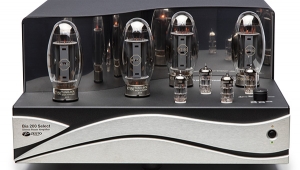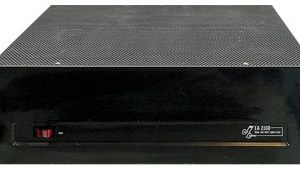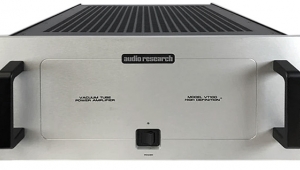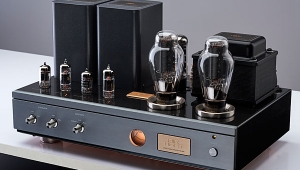| Columns Retired Columns & Blogs |
Wavelength Audio Gemini monoblock power amplifier
"I'm a fan of tubes—I don't like designing with them, but I do like listening to them."—Paul McGowan, Stereophile interview, May 2000
Footnote 1: Shortly before the review was concluded, I heard from Rankin that AVVT is about to start making 45s. Gordon is currently evaluating some prototype samples.—Robert Deutsch
"Over the years I have received numerous compliments on my work, but some of the nicest have been from hard-core tube lovers who have told me that my amps 'sound a lot like tubes!' or words to that effect. I take that as high praise, indeed."—Steve McCormack, "Manufacturer's Comment" on review of McCormack DNA-125, Stereophile, December 2000

One audio designer who does like designing with tubes, and whose amplifiers definitely sound like tubes, is J. Gordon Rankin. Since 1981, his company, Wavelength Audio, has been producing tube amplifiers of the purest sort: single-ended triode with zero negative feedback. (The Wavelength Audio line also includes some preamps and DACs.) All current Wavelength amplifiers are low-powered, one of them having a rated output of 1.5W! (Yes, there's a decimal point there.)
Obviously, amplifiers like this must by used with speakers of higher-than-normal sensitivity if they are to produce anything but the most muted sounds. Their natural partnership is with horns. Rankin's own reference speaker is the horn hybrid Avantgarde Uno 2.0, and after my highly favorable review of the Uno in our September 2000 issue, I received an e-mail from him suggesting a review of the new Wavelength Gemini, an amplifier whose output ranges (depending on the tubes used) from 2W to 5W. Knowing the reputation that Wavelength amplifiers enjoy among horn cognoscenti, I jumped at the chance to check out this combination.
Description and Design
Without the tubes inserted, the Gemini looks not unlike a fancy box of facial tissues. The review samples had some exotic wood covering the top panel, with the appropriate cutout for the central area occupied by the tubes. Wood is used not only to add a touch of elegance—which it does—but to damp the chassis. Each amplifier uses just three tubes: a 6V4/EZ80 rectifier, 417/5842A gain/driver stage tube, and the output tube, which can be a 2A3 or a 45. The type of output tube used determines the power output (3.5-5W for 2A3, 2-3W for 45), effectively creating two different versions of the amplifier. (The specific brand of tube used will also have an impact on the sound; more on this anon.)
Each type of output tube requires a different amount of bias and B+ (supply) voltage. The bias and B+ changes are accomplished by moving a slide switch to the appropriate position, and there's a small potentiometer that needs to be adjusted to minimize hum. The switch and the hum pot are on the underside of the circuit board; there's a circular cutout in the chassis's bottom to let you reach the switch and hum pot without having to remove the bottom cover. It's not too difficult a job (a pot-adjustment tool and small flashlight are provided), but it is fiddly, and, on the review samples, the cutout was not very well aligned with the hum pot. The amplifier has to be turned on its side; fortunately, it's fairly stable in that position.
I used a RadioShack multimeter, set to read AC voltage, with its leads clipped to the amplifier speaker terminals, and adjusted the hum pot until I got the lowest reading. (Going past a certain point resulted in the hum voltage rising again.) A toggle switch on the amplifier's rear selects the 8 or 4 ohm output transformer tap.
Wavelength Audio is a very small company; each amplifier is built by J. Gordon Rankin himself, who proudly points out that the Gemini has no solid-state circuits. The design uses AC heaters, which are said to result in more realistic sound than DC heaters in this application. The Gemini uses a grid choke instead of a grid resistor on the output tube, which allows greater headroom on peak output. The Gemini is capacitor-coupled, an approach that, according to Rankin, produces better superior transient performance than the direct-coupled approach.
The output transformer, grid choke, and power transformer are all unique, hand-wound designs made for Wavelength by MagneQuest. Resistors and capacitors are all carefully selected for optimum sonic results. Low-wattage resistors are Shinko tantalums (with silver leads); high-wattage resistors are Mills Precision wire-wounds. In his latest amplifier designs, including the Gemini, Rankin has started using Black Gate capacitors, which he finds sound better. "Most engineers can't seem to figure out why this should be the case. Neither do I, but they sound great, so I use them."
As for the decision to design an amplifier around the 45, a tube introduced in 1929 and not manufactured since the 1950s (footnote 1), I couldn't find a really satisfactory explanation. Still, many people—including Rankin—are of the opinion that it has the potential to sound better than such tubes as the 2A3 and the 300B. "If you can run with 2.5W, then the 45 would always sound better. But there are many people in audio, and we don't all listen and design the same way. So it's best to try both—and that's what the Gemini is all about!"
Footnote 1: Shortly before the review was concluded, I heard from Rankin that AVVT is about to start making 45s. Gordon is currently evaluating some prototype samples.—Robert Deutsch
- Log in or register to post comments



































